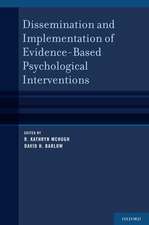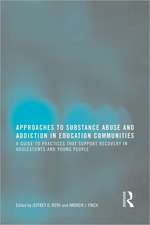Vicarious Trauma and Disaster Mental Health: Understanding Risks and Promoting Resilience: Psychosocial Stress Series
Editat de Gertie Quitangon, Mark R. Evcesen Limba Engleză Paperback – 28 ian 2015
| Toate formatele și edițiile | Preț | Express |
|---|---|---|
| Paperback (1) | 414.54 lei 43-57 zile | |
| Taylor & Francis – 28 ian 2015 | 414.54 lei 43-57 zile | |
| Hardback (1) | 1346.31 lei 43-57 zile | |
| Taylor & Francis – 16 feb 2015 | 1346.31 lei 43-57 zile |
Din seria Psychosocial Stress Series
- 5%
 Preț: 420.38 lei
Preț: 420.38 lei -
 Preț: 401.38 lei
Preț: 401.38 lei - 5%
 Preț: 344.83 lei
Preț: 344.83 lei - 5%
 Preț: 289.39 lei
Preț: 289.39 lei - 5%
 Preț: 458.28 lei
Preț: 458.28 lei - 5%
 Preț: 482.31 lei
Preț: 482.31 lei - 16%
 Preț: 340.88 lei
Preț: 340.88 lei -
 Preț: 472.08 lei
Preț: 472.08 lei - 5%
 Preț: 443.98 lei
Preț: 443.98 lei - 5%
 Preț: 526.76 lei
Preț: 526.76 lei - 5%
 Preț: 417.65 lei
Preț: 417.65 lei - 19%
 Preț: 198.29 lei
Preț: 198.29 lei - 5%
 Preț: 490.62 lei
Preț: 490.62 lei - 5%
 Preț: 465.12 lei
Preț: 465.12 lei - 5%
 Preț: 470.90 lei
Preț: 470.90 lei - 21%
 Preț: 816.34 lei
Preț: 816.34 lei -
 Preț: 442.50 lei
Preț: 442.50 lei - 17%
 Preț: 387.84 lei
Preț: 387.84 lei - 5%
 Preț: 457.32 lei
Preț: 457.32 lei -
 Preț: 315.51 lei
Preț: 315.51 lei - 5%
 Preț: 1017.95 lei
Preț: 1017.95 lei - 5%
 Preț: 533.17 lei
Preț: 533.17 lei -
 Preț: 431.26 lei
Preț: 431.26 lei - 5%
 Preț: 364.96 lei
Preț: 364.96 lei - 5%
 Preț: 1346.31 lei
Preț: 1346.31 lei - 21%
 Preț: 495.86 lei
Preț: 495.86 lei - 5%
 Preț: 454.58 lei
Preț: 454.58 lei - 5%
 Preț: 394.17 lei
Preț: 394.17 lei - 5%
 Preț: 330.46 lei
Preț: 330.46 lei - 5%
 Preț: 463.63 lei
Preț: 463.63 lei - 5%
 Preț: 366.99 lei
Preț: 366.99 lei
Preț: 414.54 lei
Preț vechi: 436.36 lei
-5% Nou
Puncte Express: 622
Preț estimativ în valută:
79.35€ • 86.22$ • 66.69£
79.35€ • 86.22$ • 66.69£
Carte tipărită la comandă
Livrare economică 21 aprilie-05 mai
Preluare comenzi: 021 569.72.76
Specificații
ISBN-13: 9781138793309
ISBN-10: 1138793302
Pagini: 228
Ilustrații: 3 black & white illustrations, 37 black & white tables
Dimensiuni: 152 x 229 x 12 mm
Greutate: 0.31 kg
Ediția:1
Editura: Taylor & Francis
Colecția Routledge
Seria Psychosocial Stress Series
Locul publicării:Oxford, United Kingdom
ISBN-10: 1138793302
Pagini: 228
Ilustrații: 3 black & white illustrations, 37 black & white tables
Dimensiuni: 152 x 229 x 12 mm
Greutate: 0.31 kg
Ediția:1
Editura: Taylor & Francis
Colecția Routledge
Seria Psychosocial Stress Series
Locul publicării:Oxford, United Kingdom
Public țintă
Professional and Professional Practice & DevelopmentCuprins
Series Editor Foreword Figley Introduction I. Understanding Vicarious Trauma 1. What is vicarious trauma Evces 2. What factors can predict susceptibility to vicarious trauma Quitangon, St. Cyr, Nelson 3. What are the barriers to addressing vicarious trauma? Hammerslough II. Understanding Disasters 4. What do we need to know about disasters? Quitangon 5. How different is Psychological First Aid from other psychotherapeutic modalities? Watson 6. How do we understand disaster-related vicarious trauma, secondary traumatic stress and compassion fatigue? Naturale III. Understanding Vicarious Resilience 7. What Is vicarious resilience? Nelson, St. Cyr 8. What factors are associated with vicarious resilience? Nelson, St. Cyr 9. What are there positive effects from working with victims of trauma? Nelson, St. Cyr IV. Managing Vicarious Trauma in Disasters 10. How do we measure vicarious trauma? St. Cyr 11. How can we rescue ourselves from vicarious trauma? Kaplan 12. What can organizations do to address vicarious trauma in disasters? Quitangon, Evces V. Navigating Resources on Vicarious Trauma and Disaster 13. What resources are available on vicarious trauma? Iqbal, Lavy, Evces 14. How do we navigate relevant information on disasters? Ryu, Lavy, Evces Appendix Index
Recenzii
"Drs. Quitangon’s and Evces’s collective vision has created a book on a much neglected topic for a field that neglects itself in the rush to help others. No longer can we as disaster mental health professionals so readily overlook helping ourselves, as this book provides the mandate and resources for it to be very much otherwise. Disaster relief organizations should make this compassionate, scholarly, and practical book a pre-deployment requirement."
—Craig L. Katz, MD, director of the program in global mental health and clinical associate professor of psychiatry and medical education at Icahn School of Medicine at Mount Sinai
"The experiences of 9/11 left mental health responders with serious wounds and the field of disaster mental health with important questions about how to better protect responders from the effects of vicarious trauma. Filled with fascinating personal accounts by those on the ground, this evidence-based book teaches us about the nature of vicarious trauma and its impact. Most importantly, it gives us practical tools, strategies, and resources to promote vicarious resilience."
—Linda Ligenza, LCSW, clinical services director and faculty for trauma-informed care initiatives at the National Council for Behavioral Health
"This book is an unusually comprehensive resource on disaster mental health interventions and the resulting vicarious traumatization that workers may experience. Theory and research are richly illustrated with first-person accounts from those working in post-disaster settings. It is a useful guide for anyone who risks their own well-being to help others recover and accommodate new realities."
—Laurie Anne Pearlman, PhD, lead author of Treating Traumatic Bereavement: A Practitioner’s Guide
—Craig L. Katz, MD, director of the program in global mental health and clinical associate professor of psychiatry and medical education at Icahn School of Medicine at Mount Sinai
"The experiences of 9/11 left mental health responders with serious wounds and the field of disaster mental health with important questions about how to better protect responders from the effects of vicarious trauma. Filled with fascinating personal accounts by those on the ground, this evidence-based book teaches us about the nature of vicarious trauma and its impact. Most importantly, it gives us practical tools, strategies, and resources to promote vicarious resilience."
—Linda Ligenza, LCSW, clinical services director and faculty for trauma-informed care initiatives at the National Council for Behavioral Health
"This book is an unusually comprehensive resource on disaster mental health interventions and the resulting vicarious traumatization that workers may experience. Theory and research are richly illustrated with first-person accounts from those working in post-disaster settings. It is a useful guide for anyone who risks their own well-being to help others recover and accommodate new realities."
—Laurie Anne Pearlman, PhD, lead author of Treating Traumatic Bereavement: A Practitioner’s Guide
Notă biografică
Gertie Quitangon, M.D., is a clinical assistant professor of psychiatry at the New York University School of Medicine and is on faculty at the NYU Public Psychiatry Fellowship. She is currently the Medical Director at Chapel Street Center, a community-based outpatient clinic of the Department of Veterans Affairs New York Harbor Healthcare System.
Mark R. Evces, Ph.D., is a clinical instructor of psychiatry at the New York University School of Medicine and Assistant Director of mental health at the WTC Health Program NYU School of Medicine Clinical Center of Excellence.
.
Mark R. Evces, Ph.D., is a clinical instructor of psychiatry at the New York University School of Medicine and Assistant Director of mental health at the WTC Health Program NYU School of Medicine Clinical Center of Excellence.
.
Descriere
Vicarious Trauma and Disaster Mental Health focuses on the clinician and the impact of working with trauma victims in the aftermath of massive disasters.













